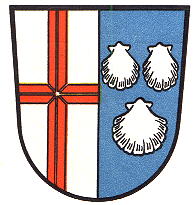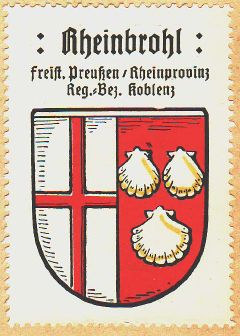Rheinbrohl: Difference between revisions
Knorrepoes (talk | contribs) (Created page with '{|width="100%" style="color:black; background-color:#ffffcc;" |width="15%"|50 px|left |width="70%" align="center" |'''Heraldry of the World<br/>Civic heraldr…') |
Knorrepoes (talk | contribs) m (Text replace - "[[Literature" to "{{media}} [[Literature") |
||
| Line 25: | Line 25: | ||
|align="center"|[[File:rheinbrohl.hagd.jpg|center]] <br/>The arms in the [[Kaffee Hag albums]] +/- 1925 | |align="center"|[[File:rheinbrohl.hagd.jpg|center]] <br/>The arms in the [[Kaffee Hag albums]] +/- 1925 | ||
|} | |} | ||
{{media}} | |||
[[Literature]] : Stadler, 1964-1971, 8 volumes; Hupp, O: [[Kaffee Hag albums]], 1920s | [[Literature]] : Stadler, 1964-1971, 8 volumes; Hupp, O: [[Kaffee Hag albums]], 1920s | ||
Revision as of 04:17, 9 July 2014
| Heraldry of the World Civic heraldry of Germany - Deutsche Wappen (Gemeindewappen/Kreiswappen) |
RHEINBROHL
State : Rheinland-Pfalz
District (Kreis) : Neuwied
Verbandsgemeinde : Verbandsgemeinde Bad Hönningen
Official blazon
Gespalten von Silber und Blau; vorn ein durchgehendes rotes Balkenkreuz, hinten drei, zwei zu eins gestellte silberne Pilgermuscheln.
Origin/meaning
The arms were granted in 1949.
The arms first appear on the seal of the village, dating from the early 17th century. On the seal the patron saint, St. Gertrud is shown as a supporter behind the shield. The shells are most likely derived from the arms of the Metternich family. Therefore the arms date from around 1610 when Lothar von Metternich was Archbishop of Trier. Hupp explained the shells as from the arms of Archbishop Jacob von Sierk (1439-1456, the shells are then canting, as they ar ethe attribute of St. James, Jacobus), and thu sof older origin. The town historically belonged to the State of Trier. The red cross is the symbol of the State of Trier.
| The arms in the Kaffee Hag albums +/- 1925 |
Contact and Support
Partners:
Your logo here ?
Contact us
© 1995-2025, Heraldry of the World, Ralf Hartemink 
Index of the site
Literature : Stadler, 1964-1971, 8 volumes; Hupp, O: Kaffee Hag albums, 1920s












